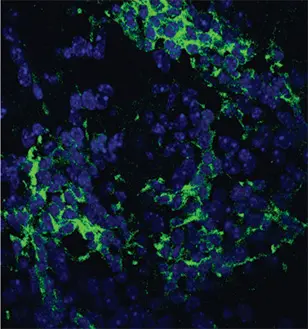Scientists from the German Cancer Research Center (Deutsches Krebsforschungszentrum, DKFZ) have now shown for the first time that malignant brain tumors arise directly from brain stem cells. In the adult brain, the Tlx protein is responsible for generating new neurons from tissue stem cells. Overproduction of Tlx in mice stimulates the development of malignant brain tumors from brain stem cells. Tlx also plays an important role in glioblastoma, the most malignant of human brain cancers. Therefore, the discovery of Tlx might provide the first target for a specific therapy against deadly glioblastoma.
The “cradle“ of new neurons in the adult brain is well known. It is what is called the subventricular zone, a tissue structure lining the lateral ventricles. This is where neural or brain stem cells reside, which are responsible for generating new neurons if needed. For many years now, the subventricular zone has been suspected to be the origin of specific malignant brain tumors called gliomas, the most deadly type of which is glioblastoma.
Scientists from the divisions of Professor Dr. Günther Schütz and Professor Dr. Peter Lichter at the German Cancer Research Center (Deutsches Krebsforschungszentrum, DKFZ) have recently shown in mouse brains that brain stem cells in the subventricular zone are characterized by a specific molecule: Protein Tlx, a transcription factor, which stimulates the activity of various genes. In the adult animal, Tlx is expressed exclusively in brain stem cells. When the scientists switched off Tlx, there were no more detectable stem cells in the brain and the formation of new neurons ceased. Functioning of the stem cells thus appears to depend on the presence of this protein.
In their recent study, the teams headed by Günther Schütz and Peter Lichter, jointly with Professor Dr. Guido Reifenberger of Düsseldorf University, have now tested the opposite case: What happens if the production of Tlx is increased? Using a molecular-biological trick, the investigators induced an overproduction of Tlx by the brain stem cells of mice. As a result, cell division activity in the subventricular zone increased, the cells left their habitual environment called stem cell niche, and started forming glioblastoma-like tissue lesions. In another experiment in which the researchers additionally switched off the p53 protein as an important cancer brake, invasively growing glioblastomas arose from the cancer precursors.
Moreover, the scientists discovered that stem cells with increased Tlx production stimulate the formation of new vessels. This enables the cells to migrate into distant brain regions and, thus, to generate the typical coral-like growth of glioblastoma.
“We recognize brain stem cells specifically by their Tlx production. If we boost it, the tissue stem cell turns into a cancer stem cell from which malignant glioblastomas arise. Therefore, we are now able, for the first time, to hold brain stem cells directly responsible for the formation of brain tumor stem cells,“ Günther Schütz explains.
The researchers expect to be able to develop new therapies to treat glioblastoma on the basis of these results from fundamental cell biology research. Tlx seems to play its fatal role not only in mouse brains. Studying tumor tissue from glioblastoma patients, Lichter and Reifenberger discovered that the Tlx gene is often present in multiple copies and, thus, more Tlx protein is produced. “Apparently, human brain tumor stem cells also depend on Tlx. Therefore, we can now try to develop therapies that are directed very specifically against Tlx producing cells,“ said Schütz describing the next steps. The mice whose brain stem cells overproduce Tlx are an ideal model system for such investigations.
Hai-Kun Liu, Ying Wang, Thorsten Belz, Dagmar Bock, Andrea Takacs, Bernhard Radlwimmer, Sebastian Barbus, Guido Reifenberger, Peter Lichter and Günther Schütz: The nuclear receptor tailless induces long term neural stem cell expansion and brain tumor initiation. Genes & Development, April 1, 2010
A picture for this press release is available on the Internet at:
www.dkfz.de/de/presse/pressemitteilungen/2010/images/DCX_308.jpg
Figure caption: Mice overexpressing Tlx develop glioma initiating lesions
Photography: Haikun Liu, German Cancer Research Center
About DKFZ
With more than 3,000 employees, the German Cancer Research Center (Deutsches Krebsforschungszentrum, DKFZ) is Germany’s largest biomedical research institute. DKFZ scientists identify cancer risk factors, investigate how cancer progresses and develop new cancer prevention strategies. They are also developing new methods to diagnose tumors more precisely and treat cancer patients more successfully. The DKFZ's Cancer Information Service (KID) provides patients, interested citizens and experts with individual answers to questions relating to cancer.
To transfer promising approaches from cancer research to the clinic and thus improve the prognosis of cancer patients, the DKFZ cooperates with excellent research institutions and university hospitals throughout Germany:
- National Center for Tumor Diseases (NCT, 6 sites)
- German Cancer Consortium (DKTK, 8 sites)
- Hopp Children's Cancer Center (KiTZ) Heidelberg
- Helmholtz Institute for Translational Oncology (HI-TRON Mainz) - A Helmholtz Institute of the DKFZ
- DKFZ-Hector Cancer Institute at the University Medical Center Mannheim
- National Cancer Prevention Center (jointly with German Cancer Aid)
The DKFZ is 90 percent financed by the Federal Ministry of Research, Technology and Space and 10 percent by the state of Baden-Württemberg. The DKFZ is a member of the Helmholtz Association of German Research Centers.



